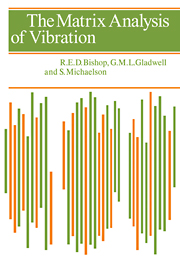Book contents
- Frontmatter
- Contents
- Preface
- Chapter 1 Notation and elementary properties of matrices
- Chapter 2 The vibration of conservative systems having a finite number of degrees of freedom
- Chapter 3 Linear equations
- Chapter 4 Further development of the theory of conservative systems
- Chapter 5 Damped forced vibration
- Chapter 6 Continuous systems
- Chapter 7 The solution of linear equations and the inversion of matrices
- Chapter 8 Iterative methods for characteristic value problems
- Chapter 9 Direct methods for characteristic value problems
- Appendix
- Answers to examples
- Index
Chapter 3 - Linear equations
Published online by Cambridge University Press: 24 November 2009
- Frontmatter
- Contents
- Preface
- Chapter 1 Notation and elementary properties of matrices
- Chapter 2 The vibration of conservative systems having a finite number of degrees of freedom
- Chapter 3 Linear equations
- Chapter 4 Further development of the theory of conservative systems
- Chapter 5 Damped forced vibration
- Chapter 6 Continuous systems
- Chapter 7 The solution of linear equations and the inversion of matrices
- Chapter 8 Iterative methods for characteristic value problems
- Chapter 9 Direct methods for characteristic value problems
- Appendix
- Answers to examples
- Index
Summary
Oh! Then your lordship is of opinion that married happiness is not inconsistent with discrepancy in rank?
H.M.S. PinaforeIn Chapter 1 we gave an account of elementary matrix theory and this was sufficient for the discussion of simple dynamical systems presented in Chapter 2. The reader who wishes to follow up this introductory theory by a systematic study of matrix methods has now three possibilities from which to choose.
The reader who is new to the subject, or whose interests are essentially practical, may wish to pass on immediately to Chapter 5. By this means he will escape what is necessarily a more mathematical portion of the book without missing any of the physically more important matters of dynamics.
Secondly, the reader who wants a fairly complete treatment of dynamical problems, but whose mathematical background is limited, should study §§3.1, 3.2, the first part of §3.7 and the whole of Chapter 4. In this way he will become familiar with the matrix analysis of systems having repeated natural frequencies. These systems do not occur exactly in reality, but they are important because they may be approximated very closely by real systems. Their analysis requires a little more care, but this is rewarded by added insight into the nature of vibration in general.
- Type
- Chapter
- Information
- The Matrix Analysis of Vibration , pp. 95 - 129Publisher: Cambridge University PressPrint publication year: 1979

